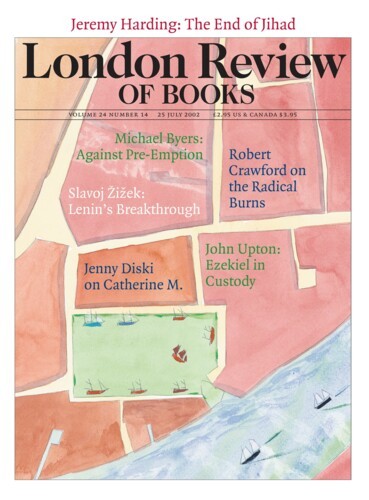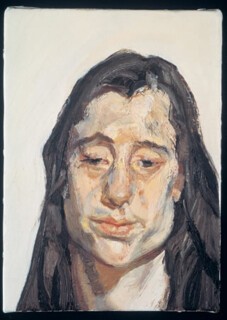Back in 1982, as we came out of a show of Lucian Freud’s paintings at Anthony d’Offay’s gallery in Dering Street (it had not been a brief visit), a friend asked what I thought of the rat. ‘What rat?’ I went back inside. It was, of course, there – dark, bright-eyed, its tail draped across the thigh of the man who leans back on a sofa in Naked Man with Rat. It was a painting I had certainly looked at. I’m not sure what had stopped me seeing it. After all, the man’s parted legs make his genitalia (and the attendant rat) the first thing the eye goes to – or at least the second, after his face. Some part of me didn’t want to look, or admit to having seen – or perhaps I was treating the picture as you might a person in a hospital ward whose dressing-gown falls open, making you aware of something on the periphery of vision it would be kinder/ more polite/less embarrassing not to notice.
Faced with a mass of Freud’s paintings like those in the retrospective at Tate Britain, which runs until 22 September,* I still feel that I have entered a room where I should not stay too long, where there may be things I would rather not – or even in some sense should not – see. The feeling that you have been led to transgress, that you are being drawn into scenes which are none of your business, is one source of the power of these pictures, for it goes along with a suspicion that this is not a transgression at all, that your pusillanimity is being found out and that a strong engagement, of a kind you have not before attempted, with the appearance of another human being is being made available to you.
The feeling is strongest in the naked portraits – a rare genre, quite different from the nude, even the informal nude, where (think of Degas) the face is often turned away, or simplified into anonymity. Velázquez seems, like Freud, to have been happy only when working from a model. He painted two nudes and you see the face in neither. Venus’ face is a blurred reflection in a mirror and in Mars (which depicts the unheroic body of a strong old man got up in drapes and a helmet) the face is in shadow. Freud’s description of the picture is just right: ‘I love his sadness and jokiness and the pointlessness of his strength. He’s no god of war. He’s a movie extra who just might get a walk-on part as Mars.’ A character has been created from what is below the neck. Faces demand their own responses and Freud’s single naked figures are, in a sense, double portraits. Manet’s Olympia was once shocking because it, too, was a naked portrait.
Though Freud is happier to quote French influences, to find precedents for his way of seeing bodies one has to look north, to Dürer’s drawing of his own face and emaciated body after an illness. The saved and damned in Northern Last Judgments are less fleshly than Freud’s naked people, but the sense they give of individual vulnerability is closer to his spirit than, say, the gratified, assured flesh Courbet (another of Freud’s enthusiasms) painted.
The nature of the relationship between painter and subject which the pictures evoke is mirrored in the information they give about the rooms in which they were made. A sense grows of discomfort and confinement: the chill Hotel Bedroom in which the painter stands silhouetted above his wife (Caroline Blackwood at that time) on the bed; the bleak room in Paddington where Harry Diamond stands truculently in his mac by the window. One knows the rooms which have served as studios both from the landmarks that reappear in picture after picture (the furniture, the pile of rags, the sink) and, negatively as it were, from paintings of views from the windows. When compared with other interiors celebrated in painting over the last hundred years – Bonnard’s bathroom, Vuillard’s family dining-room, let alone Matisse’s studios – Freud’s are ascetic, they are workspaces, not living-rooms.
Nor do they seem big. The distance between the canvas and the subject is, by historical standards short. Lord Leighton reckoned the distance between artist and model should be three times the height of the figure – 18 feet for a six-foot man. Whatever one makes of such rules of thumb, they suggest that the close, wide-angle view is one which (almost certainly through seeing so many photographs) we have been willing to accept only in the last century. You find it, for example, in Degas and Lautrec – but not earlier, I suspect. They also use views from above, another characteristic of Freud’s pictures, whereas classic portraiture puts the head of the subject at the same level as that of the painter, or even above it. (Thus the model throne, the platform that raises the sitter to the level of the standing painter.) In photography a portrait lens is one of fairly long focal length. Fill the frame with a face when using a normal lens and it takes on the round look of Freud’s Bacon portrait.
If getting close to his subjects, and very often also looking down on them, marks Freud’s framing as modern, his way of using paint is full of references to old pictures. There is a move from detailed images made with small brushes to ones broadly handled in increasingly thick, tacky paint. Freud describes the transition: ‘My eyes were completely going mad, sitting down and not being able to move. Small brushes, fine canvas. Sitting down used to drive me more and more agitated. I felt I wanted to free myself from this way of working. Hotel Bedroom is the last painting where I was sitting down; when I stood up I never sat down again.’ Which makes you think about sitting and standing self-portraits: Hogarth sitting – keen, you feel, to get closer to the canvas. Velázquez in Las Meninas standing – clearly needing to move back to see how his latest mark is working.
In Freud’s later, freer pictures the puckering of cheek or belly is described by marks which strongly differentiate plane from plane. The pale early palette, which probably understates the difference in colour between one patch of skin and another, is replaced by a richer one. Flesh painted in yellow-grey, pink, brick and dirty white takes nature’s tonal range up a notch. Frans Hals might seem to be a point of reference, but in his pictures, flickering, drawn strokes suggest that he used more fluid paint and a more flexible brush than Freud – and took less time, too. Freud takes advantage of the almost infinite freedom oil gives to overpaint, scrape, repaint and correct. Hals’s portraits leave evidence of no such rebuilding. Genre subjects like the Louvre Gypsy Girl as well as the most solemn of his group portraits record fleeting expressions which, on the evidence we have of the time taken to paint analogous modern pictures – some of Sargent’s portrait sketches for example – would seem to have been done in hours rather than days. To demand or buy the time of others – to make them subjects in two senses of the word – is a very personal assertion of power. The hero in heroic portraiture or surgery is the person under the brush or knife, not the one who wields them. Forced into passive obedience, many of Freud’s subjects are shown sitting slumped or lying down, glassy-eyed or asleep.
Because every square inch of canvas relates to observed structures there is no Expressionist near-abstract puddling with paint in the manner of, say, Soutine. Nor are there the elisions and simplifications Auerbach uses to paraphrase a face or a landscape. But the oddities of proportion and perspective which one reads as calculated, naive stiffness in the early pictures remain to some degree in the later ones – although now cloaked in the fuller substance of thick paint. This contributes to a structural uneasiness which is not so far in its effect from more wilful Expressionist distortions. The work gathered in this exhibition – which is formidable in quantity, ambition and achievement – can visually and emotionally buffet you in a way which suggests that there are pictures here which are more likely than some more obvious candidates (those of Bacon, for example) to seem, as years pass, specifically, if not always happily, of our time.
Send Letters To:
The Editor
London Review of Books,
28 Little Russell Street
London, WC1A 2HN
letters@lrb.co.uk
Please include name, address, and a telephone number.


